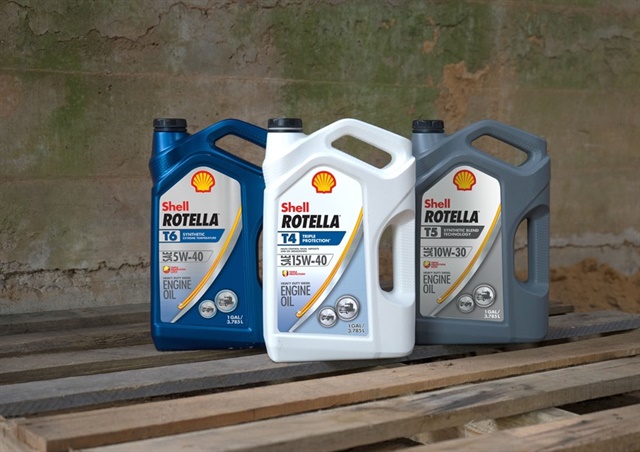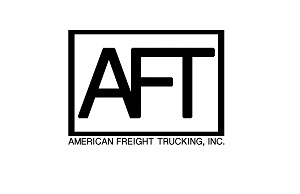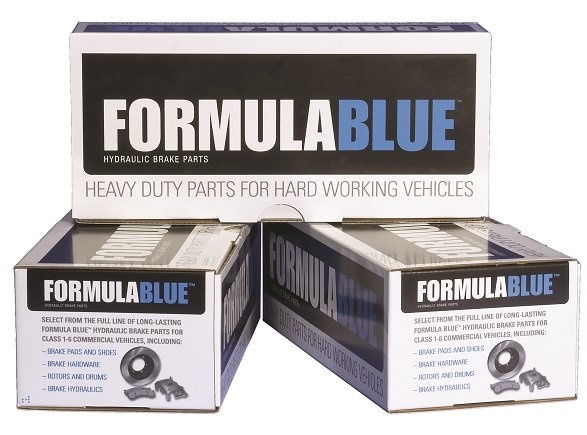Shell Debuts Oils Formulated for API CK-4 and FA-4 Categories
Image: Shell Lubricants
">Image: Shell Lubricants
">WASHINGTON, DC. Years of work in the lab and millions of miles of road testing has culminated in three new Rotella engine oils formulated to meet the API CK-4 and FA-4 oil-service categories that will start coming on the market later this year, Shell Lubricants announced here at a July 19 media briefing.
“We have been working on the new CK-4 and FA-4 specifications for more than five years, keeping in mind that meeting the new specifications was simply a starting point for Shell Rotella,” said Chris Guerrero, Brand Marketing Manager for global heavy-duty diesel engine oil.”
Once industry product licensing begins in December, CK-4 oils will replace current CJ-4 oils and will be completely backwards-compatible with all current engines, according to Shell. To meet the CK-4 specs, oils will be formulated with improved oxidation resistance, shear stability and aeration control.
To meet FA-4, oils will also be formulated with lower viscosity grades designed for next-generation diesel engines— those of model year 2017 and newer-- to help maximize fuel economy without sacrificing engine protection, the company stated.
Also per Shell, because some older engines were not designed to operate with lower-viscosity oils, the backwards-compatibility of FA-4 products will be limited by individual engine makers.
Rotella T4 Triple Protection, offered in 15W-40 and 10W-30 grades, will meet the CK-4 spec while Rotella T5 Ultra10W-30 Synthetic Blend will comply with FA-4. However, no product will be marked with the API CK-4 or SA-4 donut until December 1, the date of first licensure for both categories.
Rotella T5 Ultra 10W-30 will be introduced in December. It's formulated for improved fuel economy compared to Rotella CK-4 oils yet offers “equivalent wear protection to CK-4 products,” according to Shell.
The company noted that Rotella T5 Synthetic Blend 15W-40 and Rotella T6 Full Synthetic 5W-40 will also be reformulated to meet CK-4 specifications. Also to be rolled out will be Rotella T6 Multi-Vehicle 5W-30, which will meet CK-4 and SN category specs so it can be used in both diesel and gasoline engines.
“Shell Lubricants has been a leader in the development and testing of next generation engine oils that will meet the new API specifications without compromising oil life or wear protection,” said Dan Arcy, Global OEM technical manager. “We've conducted more than 40 million miles of real-world testing to demonstrate the performance of our next-generation engine oils to meet the CK-4 and FA-4 specifications.”
According to Arcy, T4 Triple Protection oil will “effectively sustain emissions control system durability where diesel particulate filters and after-treatment systems are used. It provides enhanced protection against viscosity loss due to shear and improved oil aeration. The exclusive low-ash formulation helps protect the exhaust catalysts and diesel particulate filters found on the latest low-emission vehicles.” He added that a fuel-economy benefit may be realized from running the 10W-30 grade of this oil.
As for the 15W-40 T4, Arcy said it will provide “wear protection beyond CK-4 standards. In API industry wear tests, T4 Triple Protection 15W-40 didn't just meet CK-4 specs, it delivered an average 50% more wear protection than required. It also provided strong wear protection in CK-4 engine tests, including the Cummins ISM and ISB.”
He added that the T4 Triple Protection 15W-40 will “defend against deposits and help keep engines cleaner over the entire oil drain interval. It delivers reduced deposits in engine tests including Caterpillar 1N and OM 501.”
Rotella T5 Ultra 10W-30 has been enhanced with synthetic base oils, plus advanced additive technology to provide “Triple Protection Plus technology that adapts to driving conditions,” Arcy said. “It provides excellent wear protection and deposit control/cleanliness. It also protects against oil breakdown and sustains emission control system durability in particulate filters and aftertreatment systems.
He said that T5 Ultra “delivers excellent wear protection and deposit control/cleanliness. It also provides protection against oil breakdown and sustains emission control system durability in particulate filters and aftertreatment systems. And tests prove that this new oil has better cold cranking properties and low temperature pumpability at -25˚C and -30˚C respectively.
Arcy noted that T5 Ultra has been shown to provide a 1.6% fuel economy improvement compared to 15W-40 oil in an independent third-party test.
Guerrero called the new oils Shell's “most technically advanced, hardest working products to date.”
He said that selecting the proper engine oil will be easy once the new API categories kick in: “If it was built prior to 2016, whether it is on- or off-highway, choose CK-4 oil, which directly replaces CJ-4 oils. For a 2017 on-highway vehicle,; check with the manufacturer before changing the oil for the first time and if they allow an FA-4 oil, choose Rotella T5 Ultra 10W-30.”
The new products will come in new packaging “to protect the recognizable look of our bottles while simplifying the naming and developing a strong label design to help our customers select the proper Rotella product to meet their needs,” Guerrero pointed out.
“The logical naming structure of T4 to T5 to T6 and the Triple Protection identifier makes each engine oil easy to identify,” he explained. “Rotella T4 products will maintain their white bottle, T5 Synthetic Blend products their silver color, and T6 Full Synthetic products will continue in blue bottles.”
He added that the jugs will retain their “much-preferred two-handled design for easy pouring and the thinner dimension fits easily on retail shelves, in a shop or truck.” The products will be offered in one-gallon and quart jugs.
Related: Two Oil Categories Rolling to the Finish Line
Follow @HDTrucking on Twitter









